#to colonize scandinavia
Text
Lessons from the Indigenous Sami on a Voice to Parliament
Kyle Laidlaw
20 October 2022

The Sami people are indigenous to Europe, their traditional lands crossing from Russia’s Kola Peninsula to the north of Scandinavia and into the Arctic Circle.
Surviving decades of assimilation and discrimination, the Sami have fought to keep their culture alive.
They’ve also fought for elected representative bodies to be their voice to governments – known as Sami Parliaments – models that could inspire our own ‘Voice to Parliament’.
“We know what is good for us and we can speak for ourselves,” says Stefan Mikaelsson, the former President of Sweden’s Sami Parliament.
“And we don’t want…Swedish state officials to talk on our behalf.”
As Australia debates the merits and model of its own indigenous ‘Voice to Parliament’, reporter Lauren Day travels to Scandinavia to learn about the Samis’ experience.
In this stunningly beautiful film, the Foreign Correspondent crew travels for hours across the Arctic tundra to capture the Sami’s traditional way of life, filming the autumn reindeer corral ahead of the winter migration.
And the crew heads out on Norway’s spectacular fjords with the Sea Sami who traditionally rely on fish for their livelihood.
In Norway and Sweden, Day hears of the immense pressures on Sami lands and waters from a new wave of ‘green’ development sweeping across the Arctic.
The Sami Parliaments are fighting windfarms and major mine proposals to extract resources crucial for the green energy transition.
They’re fearful the projects could disrupt reindeer migration and that tailings from a large-scale copper mine could contaminate the waters of a significant fjord.
“One of the strongest weapons in the struggle is the Sami Parliament,”
say Sea Sami fisherman Torulf Olsen.
While there are limits to these Parliaments’ powers – they don’t have the right of veto or the power to make law – many feel they’re a powerful weapon in the Samis’ fight to survive.
“If it should happen that the Sami Parliament stopped existing, then I think it should be much worse for the Sami people again”
says reindeer herder, Nils Mathis Sara.
And Sara has some strong words for Australia:
“If there is someone feeling like they are not being heard then…you should aim for a system that can speak up for you, your group, such as we have here. This would be my advice.”
#indigenous#indigenous russian#culture#indigenous russia#russia#important#colonization#fypシ#fypage#landback#indigenous people#Indigenous swedish#Indigenous Finnish#Indigenous Norwegian#saami#Sami#sapmi#reindeer herders#indigenous culture#scandinavia#Indigenous Scandinavian
79 notes
·
View notes
Text
Evidence of Vikings as the first Europeans to settle in Canada in ancient times
This article explores archaeological evidence that has been discovered of early Norse Viking settlements in Canada. Archaeologists uncovered the remains of a Viking settlement dating back to around 1000AD at L'Anse aux Meadows in Newfoundland. This is considered the most compelling proof that Vikings were the first Europeans to reach Canada and North America.
The article also outlines aspects of the Viking way of life when they lived and farmed in Canada for a brief period, including crop cultivation, livestock herding, building construction and household items. Place names found in areas formerly inhabited by the Vikings provide additional clues of their presence.
While their colonies did not last more than a few generations due to climatic changes and conflicts with indigenous populations, the Vikings remarkably managed to cross the Atlantic Ocean many centuries before other major European explorations. Their voyage demonstrated for the first time that land could be found across the ocean, inspiring later navigators. Therefore, the Vikings hold an important place as the earliest known settlers of Canada, though their stay was short-lived.
Reference source : When Vikings Ruled Canadian Lands: Discovering Traces of the Early Norse Colonies
#history#ancienthistory#medievalhistory#vikings#norse#scandinavia#exploration#colonization#archaeology#canada#northamerica#firstcontact#geography#placenames
2 notes
·
View notes
Note
Hey, I noticed that in one of your posts you showed an Iron Age Finnish woman's dress. Would you happen to have a good idea of what Finnish men were wearing in that era? The information on it seems sparse. I do have a relevant book that I'm about to look through, but I'd like to hear your insight too!
Hi! Thanks for the question (and sorry for the slow answer), I do love Finnish Iron Age clothing so it's always my pleasure to write about it. I've been wanting to do a deep dive into this for a long while, so maybe I'll do at some point a post about women's dress too.
Unfortunately no one has good idea of the Finnish Iron Age men's dress (and if you find any book or other source that claims otherwise, do not trust it), since there's much fewer archaeological finds of men's dress than women's dress. The most accepted theory on why the textiles of women's dress survived surprisingly well is because of the bronze ornamentation commonly sewn into especially the fine women's dresses of the era. The bronze protected them from decomposing fully. Presumably men's dresses were not decorated similarly then. There are some finds though and we can piece together at least some kind of vague picture.
I will be discussing the period from Viking Age to Crusade Age in Finland. Viking Age is often defined to cover 800s to mid-1000s and the Finnish Crusade Age started right after the Viking Age and ended in the end of 1200s, where the Finnish Medieval era begins. Crusade Age refers to the period where mostly Swedish (also German) crusaders in the span of couple of centuries conquered lands of the Baltic-Finnic pagans. The crusades of this period targeted pagans all over eastern Baltic Sea, including Baltic-Finnic Karelians, Livonians and Estonians, and Baltic peoples, and the Scandinavia too, where Sámi people were targeted. After that the Finland and Sápmi were colonized by Norse people and stayed that way untill Finland was transferred under Russian rule, but to this day Sápmi still stays under colonial rule, including Finnish colonial rule. The current Finland was very multicultural area, mostly populated by Finno-Ugric peoples, including Sámi people, Karelians and various Finnish peoples.
It's important to understand that even just Finnish peoples where not homogeneous, but had distinct, yet of course strongly related cultures. These were Finns (suomalaiset) (yes most people we now call Finns were not in fact called that) in the coast of southwestern and western Finland, Tavastians (hämäläiset) in central-western lake-Finland and Savonians (savolaiset) in central-eastern lake-Finland. This means we can't mix findings from all over Finland to reconstruct a dress without evidencing that all the elements were actually used in one place. These three tribes had broadly similar base for their clothes, but distinctive jewelry and detailing. The big divide was and has always been between eastern and western Finnish peoples. This is because western Finnish people were in close contact through the sea with Norse people and southern Baltic-Finnic peoples, while eastern Finnish people, Savonians mostly, were influenced a lot by their proximity with Karelians. Another dividing factor was the very different environmental conditions between western and eastern Finland. The Finnish coast especially in west is very flat and fertile land, while the lake area, especially in eastern Finland is very rocky, hilly and quite infertile. The main way it effected clothing differences was that western Finland being more wealthy had more elaborate clothing. Tavastians in both occasions fall quite in between, but they tended to be more in the western cultural camp.
My most important sources are a study by a doctor of cultural anthropology, Jenny Kangasvuo, Savon historia I (Savonian history) digitized and open sourced here and the digitized archeological collection of Finnish Heratage Agency. They are all in Finnish so not very useful for most people unfortunately.
Finnish Men's Dress in Viking and Crusader Ages
The basic garments men wore were broadly similar as women. They wore a shift/shirt, knee or above-knee length dress, cloak, belt, shoes and some kind of headwear. Wool was used most commonly, though the shirt would sometimes be linen too. Even evidence of silk has been found in some western Finland graves. I would assume that would be from a dress of some great man, who traveled to gain riches, possibly with vikings. Embroidery and decoration with metals was a typical feature of the whole Eastern Baltic Sea area. In Finland during this period bronze was the most common decorative metal, but silver was used too. Decorative elements were usually woven with small bronze spirals into all kinds of patterns. Here's examples from the reconstructed Ravattula's dress (Finns) used by women.
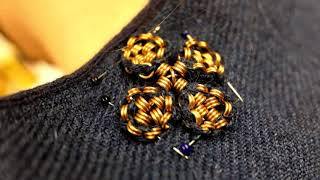

Shirt
The shirt (in Finnish shift of both women and men was called shirt) was basically a long shirt or under dress. We can assume it was similar to those of women's except shorter since the dress men wore was shorter too. They were made from wool or linen, I would assume wool was used in winter and linen in summer, when linen was even available. The neckline had a cut and closed with a bronze brooch. Horseshoe brooch was common. The first one is a quite typical bronze horseshoe brooch with a bit of ornamentation from Salo (Finns). The second one is from Tuukkala, (Savonians), it has exceptional ornate detailing and is uncommonly silver, not bronze. The third picture has two quite uniquely ornamented horseshoe brooches, first from Köyliö (Finns), second from Kurikka (Finns).
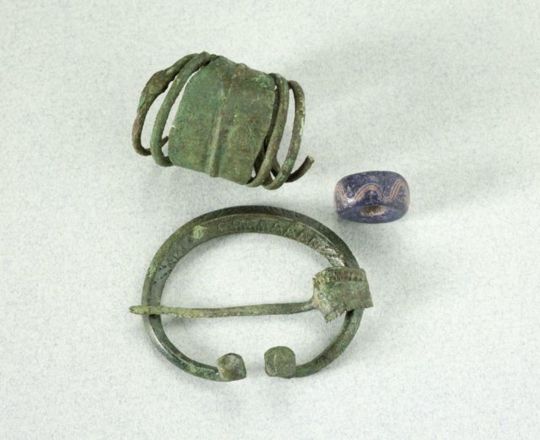
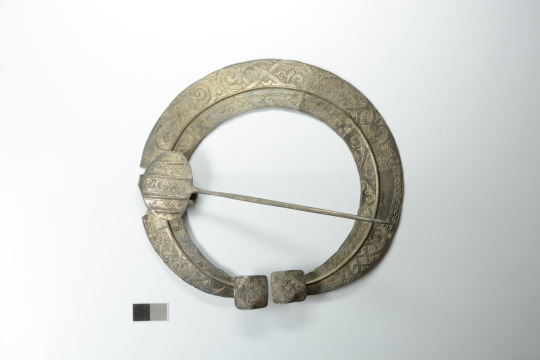
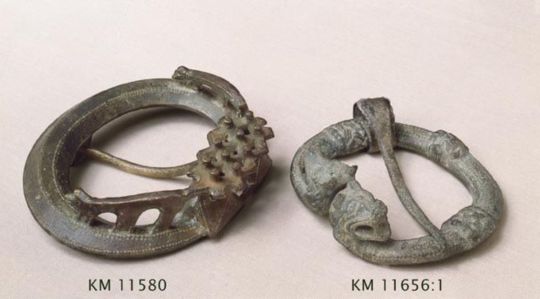
Legwear and footwear
Very little of men's legwear has survived and it's unclear weather men wore pants or separate pant legs, leg wraps or perhaps long socks. Evidence of strings decorated with bronze spirals and tablet woven band has been found in leg area of men's graves. This could mean that they wore either leg wraps, long sock or some sort of pant legs that needed to be secured with string or band under knee. Women used strings and tablet woven tape to secure leg wraps and socks, which I think supports that theory. Sometimes both bronze decorated string and tablet woven band was found in the leg area, which would still be explained by this theory, since it was common to decorate the ends of the bands with bronze decorated strings. Here's an example of sock bands just like that from the earlier mentioned reconstruction of the Ravattula's women's dress. Since men's dress was shorter, I think it would make sense if they still wore some kind of pants or separate pant legs with socks or leg wraps like that.
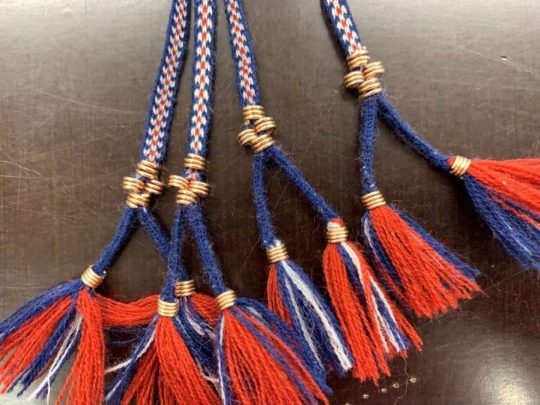
However, the strings and bands could have also been part of the shoes. Everyone probably wore similar shoes - laced leather shoes with a bit of pointed end. They might have been short or ankle length and the lacing was done with either leather cord or tablet woven band, which would also explain the findings. Socks or feet wraps would have been used in them, and straw or wool could be added as filling for warmth. Here's a pair of traditional Izhorian shoes from Estonia from early 1900s, and a pair of traditional Sámi shoes. The designs were likely roughly similar in Viking and Crusader Ages, though obviously more simple, and it's probable that Finnish shoes very something like that too. Here's a 1893 drawing of what findings of shoe material from Korpiselkä (Savonian or Karelian) might have looked like. Considering the quality of archaeology of that time, copious amounts of salt should be applied. And finally as a fourth picture there's reconstruction shoes from Ravattula's dress.


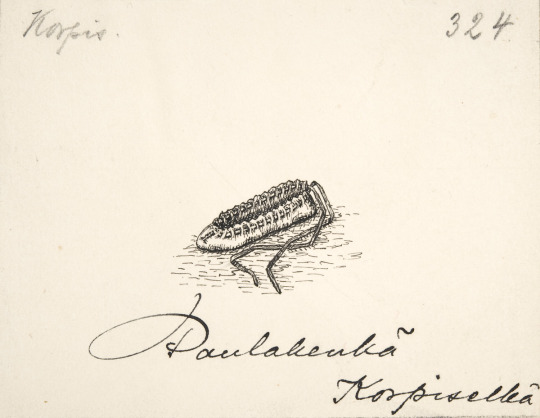
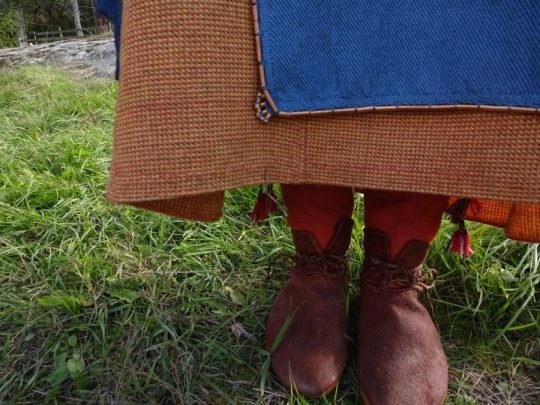
These are not necessarily mutually exclusive theories. The lacing of the shoe could have been laced up the leg and used also to secure either sock or leg wrapping, or they could have been separately secured in ankle and knee respectively.
In some graves twill fabric has been found in the leg area. It could be part of pants or for example leg wrapping, which was often made of twill. One theory about pants is that they were similar as some findings in Sweden, where fairly tight pants made of twill were secured at the hem with buttons similar to cuff studs. These kinds of cuff stud buttons are quite a common find in Finland and some have been found in men's graves close to legs.
Dress
Again there's not much findings of dresses, but a little more perhaps. It was usually from wool. The shape was either a tunic or an open coat. In Karelia there's findings of men's dress suggesting tunics thicker than women's dresses and made from sarka, a type of broadcloth. On the other hand, in Masku (Finns) they found buttons in a row on top of the torso, which suggest a coat closed with buttons. The first picture is a drawing of the grave find. Similary coak closing amounts of buttons have also been found in other places in western Finland. This suggests that Finns and probably Tavastians too wore long coats buttoned to the waist and Savonians wore tunic of Karelian influence. Below there's couple of version of what might this western Finnish men's coat dress could've looked like. The first is an imagined version of the coat based on the Masku grave finds, second is just as imagined version based on Eura (also Finns) grave finds.
Take these "reconstructions" with a strong dose of salt. These are more artistic reconstructions than scientific, since there's not enough material and too much guesswork needs to be done. And because we can see in the Masku grave drawing right here that the other deceased has a large buckle to (probably) close the shirt (to be fair, it could for a cloak too), like was typical, I find it implausible that the coat neckline would be small and round covering the buckle. If you make a decorated big buckle, I assume you want to show it. I would find a v-neckline more probable. It's also easier to make without wasting expensive fabric.

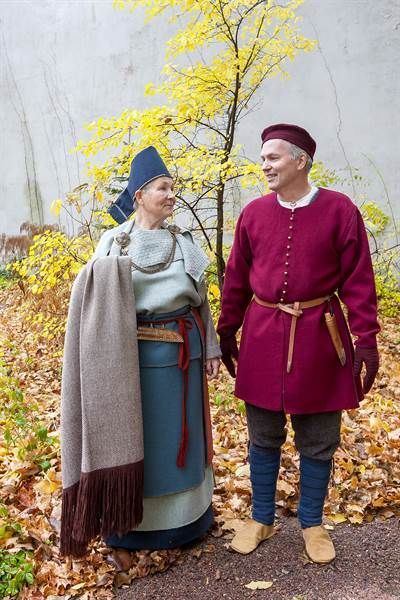

The buttons are interesting. There were what you would imagine - your typical buttons made of bronze like seen in the first artifact from Hattula (Tavastians). But then there was silver jingle bells used as buttons, found for example in both Masku and Eura graves, Eura findings pictured below.


It's possible, even probable I'd say, that the hemlines of men's dresses were finished with tablet weaving patterns, like women's dresses. Also I would assume the pattern of the men's dress (and shirt) was mostly similar to the women's underdress/shirt patterns. So here's couple of different reconstruction patterns for women's dress. Different historians have made different interpretations of the patterns, so it's very much undecided what it really was like.
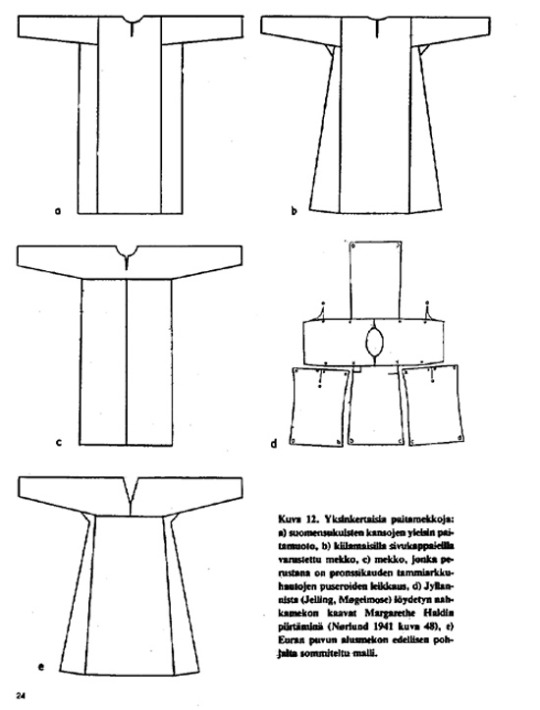
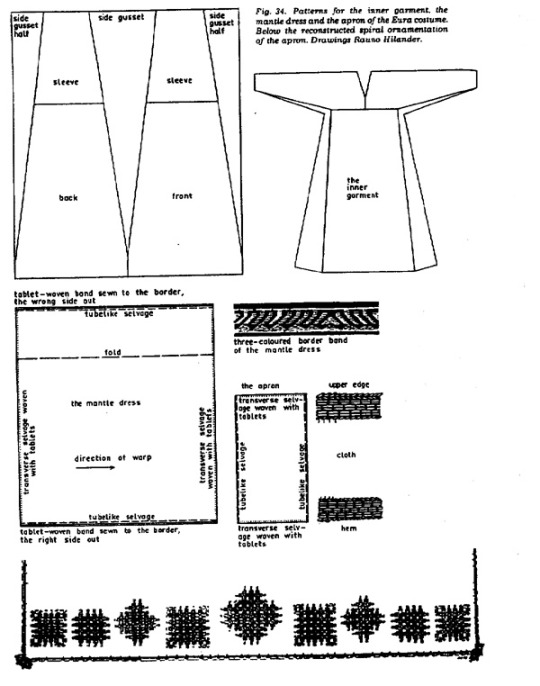
Belt
This is likely the most ornamental part of men's dress. They could be made out of leather or tablet woven band. And there's another east-west cultural divide here. Karelian belts were made out of leather, were usually 1,5-2,5 cm wide, decorated with iron or bronze studs and had a buckle made out of iron or bronze. These types of belts have been found in Savonia too, for example in Tuukkala grave find, which you can find very cool pictures of in this photo documentation of the dig in pages 173-175. In western Finland a "hela" belt was the common style. I don't think there's a world for hela in English. It's a sort of decorative lamella, small metallic plate (not necessarily square but often so) attached to fabric or leather with studs or sewing. Hela belt came from the Permians of Kama river, who were one of the many Finno-Ugric peoples who used to populate much of European side of Russia. Karelians lived closer to Permians, so you might think Permians would influence eastern Finland more, but my theory is that the costal Finns, who frequently joined viking crews and at least were in close contact with merchants including vikings, who would travel along the eastern route through the eastern European rivers, where they could go all the way to Kama river or at least meet traveling Permians. Here's yet another Finnish source more on the Finno-Ugric people around Kama river.
Anyway, hela belt was made of leather and filled with small decorated lamellas, often in square shape, but various other shapes too, like animal ornamentation. In this period hela belt helas were bronze. First image is a nice full set of hela belt metal pieces found in Pirkanmaa (Finns). Second is an older example, right before Viking Era, from Vaasa, costal settlement, (Finns), depicting a very Permian style. The third one is a lion hela found separately in Pälkäne (Tavastians). They are also found in Tuukkala, showing that both eastern and western cultural influences were present there at the same time.

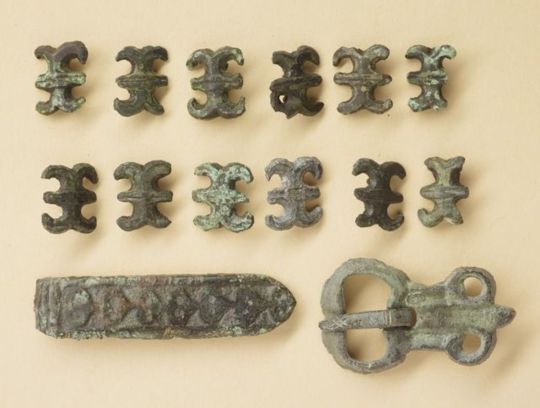
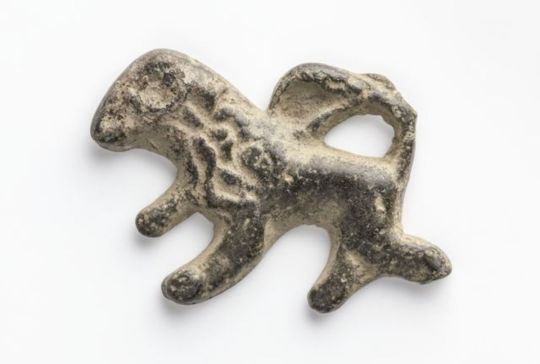
Another western Finnish belt type for men had intricate tassels decorated with bronze spirals hanging on the waist at the end of the belt. They could be made out of leather or tablet woven band. First image depicts a reconstruction of such tassel. Belts in east and west would have strap dividers to hang straps for things like purse, knife and sword. The first picture above has couple of those, but the second picture below has two more of them in more detail in the middle of the picture. These finds are from Lieto (Finns).


Cloak
Like women's cloak, men's cloak was woolen and either a square or trapezoid. Cloak is yet another east-west divide. In western Finland men's cloaks have embroidery with bronze spirals. They in fact appeared earlier in men's cloaks (in 900s) than in women's cloaks (1100s). They were also a little different in men's cloaks. The spirals and the patterns themselves were bigger and the fastening thread itself was also used for the pattern creation, unlike in women's dresses, where the thread was mostly covered. In eastern Finland there has been no finds of bronze decorations in men's cloaks, mostly only cloak brooches have been left of them. Unsurprisinly same applies to Karelia. This also means there's very little fabric left too. There's one exception. In Tuukkala (Savonians) they found a piece of fabric probably from men's cloak, though it could be from a men's dress too. It was striped, with possibly white or brown base and wide stripes of red, blue and yellow. So perhaps eastern Finnish cloak was not non-decorated, but the decoration was in the fabric pattern. Unfortunately it's hard to know how common fabric like that was, when so little of it is left.
Accessories
It's safe to assume men too wore some type of headwear, but none of those has survived. It probably means it was entirely made out of fabric whatever it was. Some type of hat or cap was certainly used in cold weather at the very least. Tablet woven headband was also possible option for not too cold weather.
In Tuukkala there was couple of interesting jewelry finds too. Two graves had a necklace type mostly found in Karelia. It was birchbark tape covered with nettle fabric and had square helas sewn into it. There were also more typical Finnish necklaces made of beads and bronze spirals.
Razors have also been found with men in their burials, so we can assume shaven faces or at least trimmed beards and moustaces were fashionable.
#dress history#historical fashion#historical clothing#fashion history#history#iron age dress#finnish iron age dress#finnish history#archaeology#answers#anon
224 notes
·
View notes
Text

The Icelandic Sheepdog is a Spitz that originated in Scandinavia.
Dogs found in graves in Denmark and Sweden from about 8000 B.C. bear much resemblance with the Icelandic Sheepdog.
As norwegian vikings set out to sea and colonized Iceland in 874, they brought their dogs with them.
56 notes
·
View notes
Text
The way that Europeans in particular say "this is US-centric" or "typical Americans" when someone (usually a white person) acts ignorant or has privilege in another country (usually outside of Europe, the US and Canada, Australia and New Zealand) as a knee-jerk reaction is actually a sign of a much deeper issue.
(Buckle up, when I say "Europeans" in this post, I mean specifically Western, Central, and Scandinavian Europe. The ones with the history of colonialism and imperialism and the strongest, most influential economies and education systems. I know Scandinavia didn't colonize the Americas, but your education and welfare systems are so high-ranked, there's no excuse for the ignorance you display. Sorry boo.)
I never get mad about people insulting my country, because quite frankly, despite being born and raised in the United States, this is the same country that's committed hate crimes towards me and my neighbors and put its imperializing little hands on our ancestral homelands. We're the ones fighting every day to make this stupid-ass country a better place.
The reason Europeans defaulting to "America stupid" is such a horrible way to respond to a westerner acting out isn't because I'm in denial of American exceptionalism, but rather because Europeans exhibit the same behaviors, and by pushing it onto another country, shift any accountability for those behaviors aside, never to address them, let alone correct them.
There's just something so ironic about Europeans dubbing two entire continents with rich, ancient civilizations "the New World," systematically wiping out the thousands of cultures here and coercing everyone to live by their own...and then turning around and laughing at the mess they made, using it as a scapegoat for when they don't want to confront the terrible things they're still doing. They're pointing at the mirror and laughing at their own reflection. "I didn't do that, they did."
#europe#us#tears falling like peridots#american exceptionalism#eurocentrism#imperialism#also all these posts that have nothing to do with america getting the “ew us centrism” treatment from europeans like way to show your asses
67 notes
·
View notes
Text
The Ghosts: Ancestry Headcanons
The Ghosts are all American, but what is their heritage and ethnicity?
The Walkers
I have a huge feeling that on Elias' side, they're English with some traces of Germany and Scandinavia in their blood. Good ol' Anglo-Saxon Vikings.
We don't know anything about Mama Walker but I'd like to think she's a mixed-race, half-white (maybe English too?) and half-latina (Mestizo), so the boys are also mixed.
Thomas Merrick
He's definitely from the British Isles and I feel like from his personality alone, he could be more from the North.
Taking in consideration of his surname which, and I quote, "derives from the personal name Meuric, which is the Welsh form of Maurice. The surname Merrick is ultimately derived from the Latin personal name Mauritius, which means "dark."" (source)
I wonder if it's a coincidence that he is more tanned than the other Ghosts.
So he's totally either English, Welsh, and maybe a little bit Irish.
Keegan P. Russ
Also North European, perhaps also Anglo-Saxon like the Walkers, but maybe leaning more on the Saxon.
Again taking the surname in consideration, Russ is usually short for Russell, and Russ is also the German and American form of the Slavic Rus which means "brownish-red", "blond", or "Russian" (source)
Keegan being a bit Slav wasn't quite on my bingo card but considering him being so aloof, gruff, and quiet, I might have no doubt he could have a little of it!
I also feel like he could have Spanish blood too because for some reason, he has a very Spanish-looking face if you know what I mean???
So in short, I think he could be a mix of mostly Anglo-Saxon, some Spanish, and a dash of Slavic.
Kick
Kick's is the hardest to ascertain because his face is not visible at all and we don't know his name, but for some reason, I've always felt like he was Asian somehow.
But canonically, his eyes are amber, and a quick Google search tells me that amber eyes are most common among people of Spanish descent but are also around in South America, South Africa, and Asia.
I'll have to put South Africa out of the list because from Kick's pictures alone, he's obviously not Black. That would leave out Spanish, South American, and Asian.
Considering that migration and inter-marriage is and was a thing, Kick could just be a mix of Spanish and Asian, though I feel like he would be more Asian from the Middle-East (considering his black hair/eyebrows)
Alex "Ajax" Johnson
He's Black, so he could be Jamaican or from another Caribbean country previously colonized by the British
His surname is Johnson, which is very obviously English/Scottish so it all adds up.
Riley
He's a German Shepherd, can it get any more obvious?
#call of duty#call of duty ghosts#call of duty headcanons#call of duty ghosts headcanons#cod headcanons#cod ghosts headcanons#cod#cod ghosts#logan walker#david walker#david hesh walker#thomas merrick#keegan russ#keegan p russ#cod kick#kick cod#cod keegan#cod merrick#cod hesh#cod logan#elias walker#cod elias#aoioozora writes#call of duty fandom#cod riley#hesh walker
35 notes
·
View notes
Text
Vikings and their eras
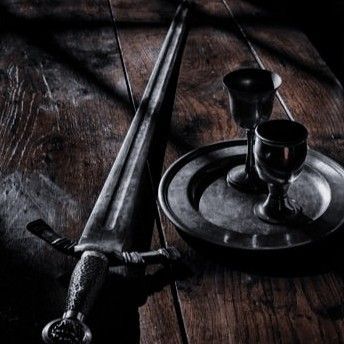
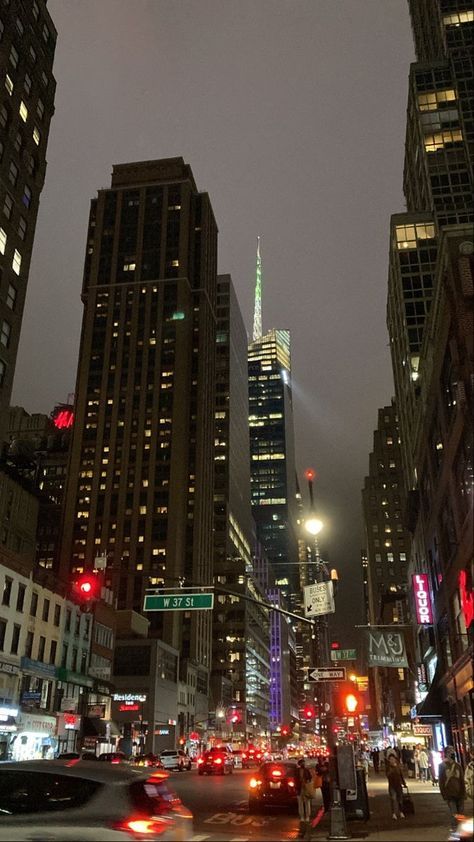
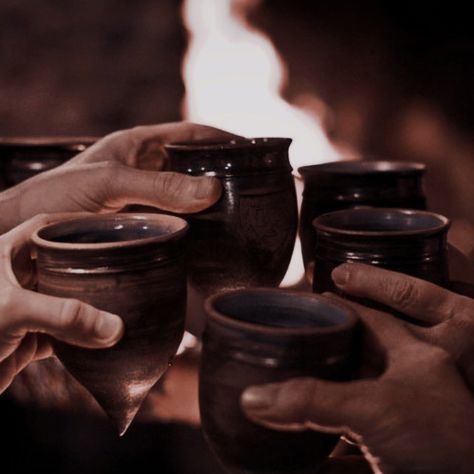
Summary: what era would vikigns be in if they weren't in their own
Notes: I did a lot of text for this one, bc I loved thinking about this!! There are some pretty popular characters missing (Ragnar, Sigurd, Athelstan) where I just couldn’t imagine a certain era for them. Thank you so much for your request :)))))) Some of these eras aren’t wonderful or filled with positivity but that doesn’t mean these characters wouldn’t thrive.
tagged: @majesticwren @obsessiveformiyatwins @leithdragon @demon-of-the-ancient-world @alicedopey, @ivarlover @levithestripper @batmandallyboy @akayxo09 @vrtualfairy (hmu to be added!)
based on this request | masterlist | requests are OPEN!
Lagertha
Lagertha would thrive well in times of crises and war (lmao). The black death, WW1 or 2, or long periods of war/famine/sickness is where Lagertha does well. Think about her what you will, but she brings people together, manages them, and takes care of them. She’s a natural leader, and a fighter, so she’s able to protect her community.
We’ve seen examples of this in the series, think during the sickness in Kattegat, or when she takes over and completely builds up Hedeby. People tend to trust her, and especially women look up to/feel safe around her. When disaster strikes, she would be able to save/take care of them.
Aslaug
I had to think about this for a really long time because I think that Aslaug fits so well into the era the show is set in, however, I finally decided on the 1920s. Even as a feminine woman in Viking Scandinavia, she had a lot of authority over herself and knew how to grow a business (Kattegat) when Hirst wasn’t feeling sexist.
In the 1920s, she’d live in a big city, maybe Berlin or New York, and she’d own some sort of speakeasy. I’d love to think that her speakeasy would be a place for the very few pagans of the city to meet up in secret, and she herself would still be a norse pagan, völva, etc. Also, she’d dip her toes into wild jewellery design (think Schiaparelli). Definitely someone who attracts artists and would be considered a muse.
Rollo
Middle Medieval Ages for sure. He thrives being a knight because he’s a manipulative little hoe that I can’t stand. Gets to do his performative heroism during tourneys and woo women only to leave them all alone.
Rollo is not a good person, esp. towards women. He constantly gets into trouble with the church and with fathers whose daughters he ‘dishonors’. Definitely needs a wife like Gisla to slap some sense into him. I think that eventually (mid forties) he’d start to mature. Also, having children would help him become a better person (I think they should have put that into a show).
Bjorn
Bjorn thrives well in the late 2000s to early 2010s, when travel blogs were on the rise. He’s one of the early influencers, and travels the world together with Halfdan. This only works bc cancel culture isn’t real yet. Bjorn would say some stupid shit and get hounded for it let’s be real. Nonetheless, there is always some rumour about him and Halfdan being a thing (they would be if they both didn’t constantly say ‘that’s gay’).
Alternatively, Bjorn might make a good colonizer (can I say that?), but it’s not like he isn’t that already.
Ubbe
Ubbe would thrive during the late medieval ages (defo not the Renaissance though). He’s the type of man who would enjoy the idea of the charming knight. I think Ubbe would definitely enjoy the idea of quests/saving damsels in distress/having the arranged-marriage-turned-lovestory (he’s a booktok girly tbh).
This doesn’t mean that all of this is totally pure. Ubbe gets some shit twisted in canon as well (ESPECIALLY concerning Margrethe). Maybe his first war was something crusade-like, and he went into it thinking of heroic acts and blabla and then got fucked up by battle and gore. Also has a religion and Madonna/whore complex problem.
Hvitserk
In the show, Hvitserk was always seeking sense/purpose while also struggling with balance, which is why I think he would thrive in the 1970s. This is THE era for protests and social change. Climate change, feminism and sexuality all became important topics. Going to protests would be able to give him a sense of change, and I think it would be liberating for him as well, to be able to free himself of his restraints by changing something.
I’ll go into communes a little more for Helga, but I think Hvitserk would thrive in an early commune a lot. He needs to have people around him taking care of his mental health, and this would be great for his mental health. Yes, therapy helps a lot of people, but I think if Hvitserk lived in our time, he would think that talk therapy is stupid, and completely close himself off to it. This guy just needs a lot of love, okay?
Also, he needs to smoke some 70s weed every once in a while.
Ivar
Just like Hvitserk, Ivar would thrive during the 1970s. However, this is for completely different reasons and also means that no one else gets to thrive. I chose the 1970s because it’s THE serial killer decade.
That honestly sounds terrible but we all know it’s true.
Ivar would be bitter about being discriminated/not being able to fully take part in society/not getting any women and that would turn him homicidal. He definitely overcomplicated his killings and does shitty bloodeagles to get some cool name but all he gets is like “the Viking killer” or something and he’s so mad about that he reveals himself on his deathbed to change his title. It doesn’t work.
Floki
Floki just wants to be where Helga is, but he would not thrive in the 2020s. I think he’d get in arguments with Helga about vaccinations. However, I want Floki to be in the 2010s/2020s with Helga. He definitely has some kind of hallucination-related mental illness at the least. I think that especially the season where he acted out against Helga (season 4?) shows that his mental health was making him harmful towards others and probably towards himself.
I can’t diagnose Floki, but I think we can all see that he might have some kind of bipolar disorder/mania disorder on top of a schizophrenia. He needs some kind of meds, and he needs someone to help him taking them.
Helga
This is very specific, but Helga would do AMAZING during the early era of Covid (like March 2020). Yes, she’s a very social person, but I do believe that Helga would be part of a quite isolated commune if she lived during modern times, and even during that time be isolated with Floki.
I would like to think that the commune could be self-sufficient and Helga just gets to go ham making banana bread and care packages. She thrives in this time where she doesn’t really have to go to work (even though she loves being a kindergartener too) and gets to take care of the people in her commune, and even further than that from the comfort of her own home.
Astrid
This woman thrives where no one else does, and that is toxic 2020s twitter. All she does is tweet, get cancelled, tweet, get popular, repeat. She’s so so annoying and bullies a bunch of people who don’t deserve to be bullied. Is most definitely blocked by trump, hailey Bieber and the Kardashians at least.
Makes a living by selling feetpics.
Ecbert
Ecbert thrives in the 1980s. Now. Hear me out. Ecbert in neon Zumba clothes. There, that’s my reason.
I’m just kidding, there’s more. I’m not old enough to fully understand most of the decades I’m talking about in here but the 1980s, it seems, were this extremely colorful and wild decade. Literally everywhere, color just kind of seemed to explode, and I think Ecbert would thrive in this kind of chaotic atmosphere.
(are there people in their forties or older on this post that can verify?)
Aelswith
I’m really sad that we didn’t go into Aelswith more in the show, but I firmly believe that Aelswith would make an amazing Sufragette. Thinking back to her time on the show, she was always very firm in standing her ground, more so than Judith or even Lagertha in some ways (especially in the sense that she was SO YOUNG). She directed and strengthened Alfred, and I think during season 6, she used a beartrap to defend her baby?
Anyway, I imagine her as a rich/aristocratic lady in London who definitely steers the household while Alfred brings the money in (he likes art) and she decides that, if she puts in the work in the house, she should be able to decide over the country that house is in as well.
#history vikings#request#vikings#ivar#hvitserk#ivar x reader#ivar the boneless#ubbe#lagertha x reader#ubbe x reader#hvitserk x reader#aelswith#rollo#aslaug#floki#vikings ivar#ivar ragnarsson x reader#rollo x reader
123 notes
·
View notes
Text






Favorite History Books || The Northern Crusades by Eric Christansen ★★★★☆
The crusades to the Holy Land are well known, or, at least, widely heard of. The crusades against the Albigensian heretics, and against the Muslims of Spain, are familiar to students of medieval history. But the crusades of North-East Europe remain outside the scope of most English readers, and are remembered, if at all, as the subject of Eisenstein’s haunting essay in nationalist propaganda, the film Alexander Nevsky. He is said to have chosen the subject because so little was known about it that the facts were unlikely to interfere with his fictions.
This book is an attempt to describe the struggles waged round the Baltic from the twelfth to the sixteenth centuries in the name of Christianity, and to explain the part they played in the transformation of Northern societies which took place at the same time. There is no room for more. The general history of the Baltic world will only be referred to in so far as it directly concerns the crusades, and the reader will have to look elsewhere for a proper account of the rise and fall of the Scandinavian kingdoms, the East European principalities, the Hanseatic League, the fish trade, the German colonization of the East, the development of cities, churches and shipping.
… Telling this story means keeping at least three balls in the air at the same time: a narrative of campaigns; a survey of ideological developments; and a sketch of political history. The crusades can be understood only in the light of, for example, the Cistercian movement, the rise of the papal monarchy, the mission of the friars, the coming of the Mongol hordes, the growth of the Lithuanian and Muscovite empires, and the aims of the Conciliar movement in the fifteenth century. Dealing briefly with all these big subjects, and linking them to the far north of Europe, has not been easy; and an English reader may well ask, is it worthwhile?
There are several reasons for answering yes. In the first place, the Northern crusades were a part of a wider Western drive, and if that is to be studied it should be studied in full – in the most unlikely places, and in the most peculiar forms. The Holy Wars of the Mediterranean brought about spectacular conquests, and enduring obsessions, but amounted in the end to a sad waste of time, money and life. After 200 years of fighting, colonization, empire-building, missionary work and economic development, the Holy Places remained lost to Christendom. The Saracens won. The two faiths remained invincibly opposed, and if the cultures mingled it was not because the Christians had attempted to conquer the Near East; there were more enduring and less explosive points of contact.
The Northern crusades were less spectacular, and much less expensive, but the changes they helped to bring about lasted for much longer, and have not altogether disappeared today. The southern coast of the Baltic is still German, as far as the Oder; and it is not sixty years since the Estonians and Balts lost the last traces of their German ascendancy and fell under a new one. Western forms of Christianity survive in all the coastlands opposite Scandinavia, and the Finns remain wedded to Western institutions and tolerant of their Swedish-speaking minority. The reborn republics of Estonia, Latvia and Lithuania look west for support and sympathy. For seven centuries these east-Baltic countries were colonial societies, bearing the mark left by their medieval conquerors whatever outside power tried to annex or change them. If ever the crusades had any lasting effect, it was here, and in Spain.
#historyedit#bookedit#medieval#european history#northern crusades#history#history books#nanshe's graphics
16 notes
·
View notes
Text
New WIP Intro

Since I finished outlining the first act of this WIP, y'all deserve a formal introduction. Especially because I am going to blabber about it a lot.
You might like it if you like...
Lgbt/queer or disabled characters
Healing magic
Polytheist religions
Themes of life, death, balance
Pirates
Detailed worlbuilding
Battles
Travelling across lands
If any of this sounds like your cup of tea, read under the cut!
The Basics
Genre: medieval fantasy, LGBT/queer, low fantasy
Setting: the universe of U'nyon-he that is divided in five islands. Wassermund, inspired by medieval Germany. Tijara, ispired by the 13th century Maghrebi area. Yue Weifeng, inspired by Ming Dinasty China. Velstand (also known as Iskald), inspired by Scandinavia. Fluye, inspired by pre-colonization Mexico.
Language spoken: the five languages, and Common language. The names of gods and the universe is in Common.
Plot
Five islands. Five gods. Four people who meet death, and get sent back with a mission. Only one, to which the mission is gifted from higher powers.
In theory it is very simple: find the Staff of Time, free the gods, reunificate the islands who have grown apart centuries ago. In practice, no one is very enthusiast about the idea of dying, serving the gods, and going back to be dead again once they are done. Especially not in a time of such upheaval.
Plus, Katz has her own way of reuniting the islands. Souad, needs to stop a war first. Jiang would like to become a famous mage before going, and Haakon has a nation to rule. Nayeli on her part, would like to understand why the gods seem to target always her.
They have been given an opportunity to do all that again, there is no way in hell they are wasting it!
Characters (the mortals)
Katz (she? they? who knows. certainly not Katz.) : A young pirate from Wassermund. Katz's main goal: joining the rebellion to make all islands more similar to Velstand, with freedom to choose more than one path in life.
Souad al-Halabi (she/her): An extremely capable merchant from Tijara who can also be an amazing on the spot diplomate.
Lin Jiang (he/him): He dreams to be a famous mage. For now, however, he is being held back a grade at the magic school in Yue Weifeng. Maybe if only he understood what is the true essence of magic, he would succeed.
Haakon Ari Holderburg (he/him): The crown prince of Velstand. He was admired and beloved by all, until his vision. Now that everyone believes him to be crazy, he has to recover his reputation as well as lead a war against Tijara. All while coming to terms with his newly acquired disability, and heavy mobility aids.
Nayeli al-Saghir (she/they): the preferred by the gods. She has been found as a baby in Tijara, now she is an estimated priestess and oracle in Fluye. They are deaf, often experience visions, and have a very developed spirituality. Her main problem, a part fetching the damn staff, is figuring out why the gods seem to only bother them.
Characters (the gods)
Ylan: God of travel and water
Elaij'ah: God of all things dying
Etris: God of all things living (twin of Elaij'ah)
Xira: God of magic
Gador: God of trades
All gods are genderless
#creative writing#writing#new wip#writeblr#wip intro#writers on tumblr#writing community#the ship of undead
73 notes
·
View notes
Note
At risk of being controversial i believe I found the best parallels between the Abrahamic religions and the nations of Scandinavia. The Swedes are the Christians of Scandinavia, the Norwegians are the Muslims of Scandinavia, and finally the Danes are the Jews are Scandinavia. Feel free to rearrange though
As a follow up to blow people's minds. Canada is the Norway of North America. The United States is the Sweden of North America. Mexico is the Denmark of North America.
none of these analogies make any sense. islam and christianity aren't ethnic groups. arabic and hebrew are much less closely related than any north germanic langauges. there is no norwegian hegira. there's never been a kalmar union of north america. and scandinavia was never colonized by outside powers.
norway has oil, and so does the arabian peninsula, so maybe a vague norway-arab analogy there...? but arabs aren't synonymous with muslims. and the big viking conquests didn't originate only in norway.
14 notes
·
View notes
Text
Flag of the United Provinces of Markland
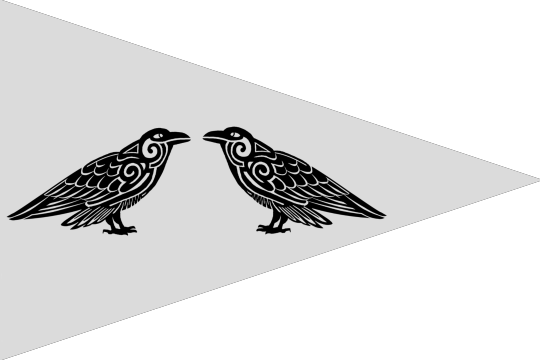
This is the flag of the United Provinces of Markland. It comes from a world in which the Norse colonization of North America was more successful. The Norse expanded into mainland North America. Most of the settlements were founded by Christians. However, some pagans also established colonies in hopes of escaping persecution in the Old World. Unfortunately, Christians had a numeric advantage, and forced the Pagans further into the interior of North America. Still, the Pagans made the best of things, and there was some trade between pagan and Christian settlements. Christian settlements tended to be based around agriculture and fishing, while Pagan settlements placed emphasis on fur trapping and hunting.
Knowledge of the Americas eventually spread to the rest of Europe, and other nations began to send their own expeditions. The indigenous peoples were exposed Old World diseases, but managed to recover their numbers by the time Europeans arrived in earnest. There are several independent indigenous nations, such as the Haudenosaunee and Lenape nations. Both nations are close allies of Markland. Christian Marklanders traditionally had a tense relationship with the indigenous peoples. By contrast, Pagan Marklanders were generally on more amicable terms with the Native Marklanders, and intermarriage wasn’t uncommon. This lead to a creation of a new culture of mixed race Marklanders. We might consider them akin to the Métis of our world.
In time, Markland began to view itself as separate from Scandinavia. This ultimately culminated in a war of independence. The Markland War of Independence saw Christians and Pagans fighting side-by-side to defend their homeland. This caused Christians and Pagans to view each other not as separate cultures, but as a single people sharing in a common destiny. The United Provinces of Markland includes most of what would have been the eastern provinces of Canada, as well as the New England states, Long Island, and New York City.
The United Province of Markland is governed by a bicameral legislature known as the Althing. The head of state known as the Speaker of the Althing. The Speaker is voted on by the people and serves a term of six years, and can be re-elected for only one more term afterward.
The Constitution of Markland places emphasis on protecting the rights of minorities, such a pagans. All provinces can declare an official religion, but they cannot penalize other religions, or lack there of. However, Pagan majority provinces are granted more leeway with what they are allowed to do, in accordance with the Constitution. Some conservative Marklanders grumble about this. They feel that pagans wield a disproportionate amount of influence in the Althing; especially given that Pagans only comprise about twenty percent of Markland’s population. However, most Christian Marklanders are perfectly willing to give small concessions to the Pagans.
Marklander Christianity is highly syncretic. Pagan Marklanders might bless a field by pulling a wagon with a statue of Freyr or Thor around it. Christian Marklanders would preform pretty much the exact same ritual, but with a statue of St. Olaf instead. The raven, rather than the dove, is consider the symbol of the Holy Spirit in Marklander Christianity.
This symbolism extends to the flag. The flag is based upon the famous Raven Banner. It is a grey triangle pennon with two ravens. The ravens represent both Christians and Pagans, and symbolize how Markland is the product of both cultures. Some conservative Christians, however, note that two raven could also symbolize Huginn and Muninn, the ravens of Odin. Conservative Christians have tried, unsuccessfully, to get the flag changed to include only a single raven. However, most Christin Marklanders are perfectly happy with the flag just the way it is, and think it look very nice.
Link to the original flag on my blog: https://drakoniandgriffalco.blogspot.com/2022/05/flag-of-united-provinces-of-markland.html?m=1
#alternate history#flag#flags#alternate history flag#alternate history flags#vexillology#alt history#Markland#Vinland#Norse#Norse Pagans#Norse Christians#United Provinces of Markland#Flag of the United Provinces of Markland#United Provinces#america#Canada#usa#united states#united states of america#Pennon#Viking#Vikings
23 notes
·
View notes
Note
Happy Birthday!! I love your comic so much, it's been so nice seeing it updating again! I guess if you want as a fun question, which of your characters has been the most fun to design so far? I really love Coal's distinctive hair and recently I really loved Hel's appearance (I hope we see her again someday~) so I'm curious which if any characters have stricken your fancy the most?
Thank you! Oh man, Coal's hair! You're a true TMK OG if you know where its inspiration comes from lol.
Designing characters is one of my favorite things to do, so narrowing down to a fave or most fun design can be tricky. But (speaking of tricky!) it might have to be Loki. When I first decided I was going to use Loki as a character, I was kind of worried. He's so popular and famous, probably the best-known character from the Norse myths even before Marvel's Thor movies were made. There's a lot of depictions of him so trying to come up with my own idea was pretty daunting.
A couple of things came together to help me create my own idea for Loki. One of them was John Bauer, an illustrator from the turn of the 20th century. I noticed a lot of his art used when looking at various Norse mythology pages. Some aspects of his depictions of Loki helped get my own gears turning.

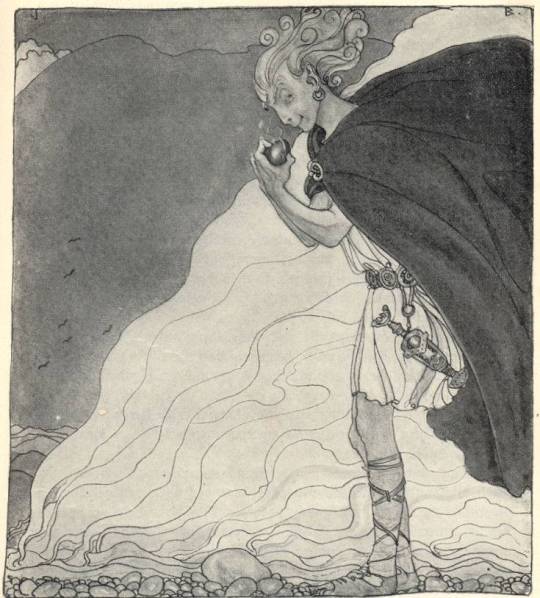
Images from: https://runeberg.org/gudasaga/
Bauer's style in general was another inspiration for me, but I remember looking at that left drawing of Loki and Idunn and thinking, "His eyes are pretty narrow and dark there...kind of reminds me of a shark...ooh what if he had black eyes?" That's where the "reverse" eyes for jotnar came from. The eyes of characters and how they define them have become a common motif in the comic.
Loki's clothes, particularly his tunic, are inspired by clothes worn by the Sámi people, though I'll admit I made up the embroidery designs. In hindsight this may not have been the most appropriate decision, but it was done before I even knew the term "cultural appropriation." I think my initial ideas were that the jotnar had a connection to the indigenous people of Scandinavia and the Aesir were more like colonizers. It's actually been argued that the Aesir/Vanir war that is mentioned in the myths is a leftover from a culture (the Aesir) arriving and conquering the locals (the Vanir). Neat stuff.
No one has said anything to me about Loki's outfit so hopefully it's okay, and I don't mean anything disrespectful by using it. When I was researching I was struck by their designs and wanted to use it somewhere prominent. The story doesn't stay in Scandinavia for long so there wouldn't have been many (any?) other chances to show it.
The colors for Loki came a little easier. I knew he would be a warmer character in TMK, even become a pseudo-dad for Coal and the other kids, so all his color choices are warm and earthy. He's supposed to look approachable and friendly--at first, anyway.
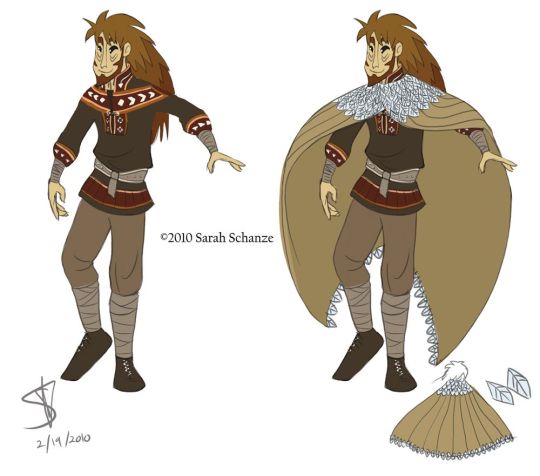
I love all the designs for the characters in TMK, but I might be proudest of Loki's, if only because it was so intimidating to do in the first place. I think it worked out well.
7 notes
·
View notes
Text
Ethnic Diversity in the Middle Ages
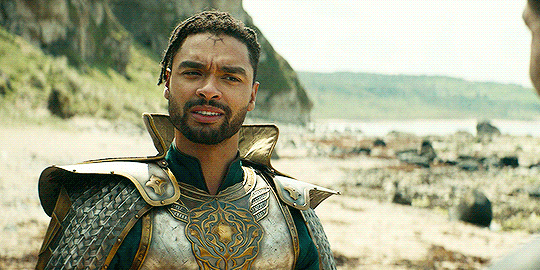
The other big thing a lot of whiny white fanboys tend to cry about when it comes to fantasy and historical medial is the existance of non-white people within medieval Europe. Which to me still is just... silly. If you know anything about European history, you should not believe something like that.
Because here is the thing: The Roman Empire also included quite a lot of Northern Africa. Where, you will not believe it, Black and Brown people lives. Who then would at times become citizens of Rome and would take over jobs within the Roman Empire. The most notable group might be the Nubian mercenaries, who were counted among the best military forces in the ancient world. As such the Roman army often took them along while they were colonizing Europe. And as it was with those things... Some of those Nubians ended up settling throughout all of Europe.
It should be noted that we have both historical evidence from Roman times, though, as well as archeological evidence that shows us that there were Black and brown people living both on the British isles and in parts of Scandinavia even prior to Rome. And no, we do not know where those came from. We just know they were there.
But even other than that... Medieval Europe was not a computer game with invisible walls. Africa was there. Asia was there. And people traded.
I said it before: The first European sources about Japan we have are from about 300 AD from a Roman merchant, who has travelled to China and then heard about the Japanese islands. It is also one of the few sources we have of someone talking about the indigenous people of Japan.
But yes, people travelled. People traded. We all hopefully know about the silk road. The trade route that went throughout Asia and ended in Europe. All sorts of stuff was traded here - and people travelled, too. And at times they ended up staying whereever they travelled to. Maybe because weather or health did not allow them to travel back, maybe because they found community in the place they travelled to.
And yes, people traded with Northern Africa, too. Now, subsaharan Africa is a different story. Yes, some people crossed over from there. But most of the trade with those areas happening during the last two centuries of the medieval period.
It also should be reminded that indeed the Mohrs ruled over Iberia throughout most of the medieval period, with reconquista only happening at the very end of the middle ages.
And of course Europe was also raided and invaded several times by the Ottomans, the Huns and the Mongols. Of whom some remained behind in Europe, too.
All of this is not to say that medieval Europe was as ethnically diverse as modern Europe is. It was not. But it was also not all white (which is of course without even going into the fact that the concept of whiteness did not yet exist).
Oh, and also realize that racism as we know it today was not really a think for at least the early medieval period. It only started to develop through the crusades (which is to say from 1100 AD forward). Something that was however a thing is religious discrimination and violence against religious minorities, which is to say mostly against jews and muslims. These especially took off, once the crusades started, but happened even before that. Which is also why a lot of Jews from Europe fled either west, to Iberia, or east, to the Ottoman empire, as muslims at the time did not discriminate against them in the same way.
#history#medieval history#middle ages#medieval#european history#diversity#cultural diversity#ethnic diversity#history of racism#fantasy#high fantasy
15 notes
·
View notes
Note
i cannot speak for sweden and denmark, but norway was forcefully christianised. it was either become christian or die and it is something we learn in school about
I admit I don't know as much about Norway since most of the people I've spoken to were Swedes, so it's possible my interpretation has a Swedish bias to it.
My understanding of the overall Scandinavian Christian conversion is that there was certainly a lot of conflict involved, yes, but it didn't result in the sweeping death of culture that we Americans tend to associate with the word "Christianization."
Here's what I'm trying to disambiguate to people on my side of the globe:
A lot of US heathens have this idea that Norse Heathenry is an "indigenous" spirituality...as in, it's thematically the same as Indigenous American spiritualities, except it's for white people. Because of this, many American heathens try to equate Scandinavia's Christianization with the colonization of Indigenous Americans.
For context, America's Indigenous societies have been (and continue to be) subjugated to not merely religious conversion, but cultural genocide. They're stripped of their languages, gods, customs, holidays, histories, and their families and ancestors, all for the purpose of colonial conquest. Hundreds of thousands of people have been killed, trafficked, and/or separated from their families, and this began the moment the Puritans stepped foot on this continent hundreds of years ago.
But it seems like Scandinavia's conversion was not the same as America's colonization, despite the fact there was conflict involved. Therefore, American heathens shouldn't view it the same way. That's what I'm really trying to get at for Heathens over here.
40 notes
·
View notes
Text
what I realistically think op characters ethnicities are
-Luffy: indigenous Brazilian (with a slight Portuguese and African mix in there)
-nami: Saami (native people of northern Scandinavia) this makes a lot of sense to me since many Sami people were tragically murdered (like namis parents) and had there children taken away. to put this into simple terms, namis parents were killed and then nami became and orphan and grew up on an Aegean island (agriculture similar to cocoyasi village)
zoro: Mongolian (got really lost as a child and ended up in Japan)
usopp: south Sudanese but grew up in South Africa(because there’s a lot of Dutch settlers there due to colonization and there were a lot of white people in syrup village)
sanji: half german half Syrian, Germa was based off Germany but sanji does use arabic words and makes “simsim cream” (sims in means sesame in Arabic) he was born in Germany but ran away and ended up in northern France (in my heart he’s 100% Albanian but this is supposed to be realistic not hcs)
Robin: native Siberian specifically nenet, similar to what I said about the Sami and nami earlier, many siberians went though genocide just like in robins backstory and how all her people were whipped out. (Robins also has a very Siberian/turkic look in my opinion coming from a 🇰🇿 girl)
Franky: Dominican that grew up in north eastern America
brook: African American from Louisiana (I can’t really explain this one it just feels right) (also brooks love for music and a lot of music types came from black Americans)
Jinbe: Indian Fijian (this one is also hard to explain it just feels so right)
extra ->
law: Sinti Romani (a big group of Romanis mainly located in Germany) btw this one is mainly due to looks bcz there’s no way in hell law is a white German lmaoo that boy is BROWN
#one piece#monkey d. luffy#roronoa zoro#one piece nami#usopp#vinsmoke sanji#nico robin#cyborg franky#brook one piece#one piece jinbe#trafalgar law#Nobody’s gonna read this long ass post I just wanted to talk abt this bcz I’m bored
4 notes
·
View notes
Text
and another thing: russia being banned while israel is allowed to participate is hardly hypocritical considering that the ebu didnt want to ban russia either lmao. they are amazingly quixotic when it comes to their apolitical ideals and only banned russia after half of eastern europe and scandinavia threatened to pull out – like they went from "its ok both ukraine and russia can participate" to "ok yeah maybe not" literally overnight. they also only banned them from last year's contest initially, which then caused russian broadcasters to withdraw from the union, and from there it snowballed into a permanent expulsion. its also not surprising if you're familiar with esc history (israel has participated twice as often and for twice as long as russia) or frankly with the cultural and political relations between europe and israel
anyway. the real hypocrisy is people on this here webbed site being able to (correctly) draw a distinction between an evil democratically backsliding empire with fucked up politics and its citizens when it's about russia ("most russians are against the war!"). or the us ("remember that americans are the first victims of american policy!"). or the uk ("terfs are a loud minority! most brits are poor and couldnt care less about the monarchy!"). or france ("support the protesters!"). or literally any other country. but when some israeli pop girly gets on stage y'all see red and scream colonizer like she's launching missiles at gaza straight from liverpool. half of you haven't touched a newspaper since your last elementary school crafting project but of course you have all the correct opinions and could solve the israeli palestinian conflict by tomorrow
26 notes
·
View notes